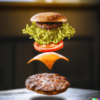Tim Landsberg, a German food stylist with 28 years of experience, talks about his beginnings as a professional chef and how that chapter of his career shaped what he practices now. The conversation was led by Rob Payton – a passionate film director with 20 years of experience… and hungry for more.
Rob: Let’s start with (what I consider) a really obvious, logical question – how did you become a food stylist?
Tim: I started out as a chef; working in high-class restaurants. Then I went on to working on my first chef book, in one of the restaurants; with a photographer. I learned about this business, about how it works; and then I worked in my first photo studio as a food stylist. That was in 1992, everything was analogue – they were real pictures. No photoshop or anything like that. I’ve been doing this job for 28 years now… so, a long time.
R: So why did you want to get out of the kitchen? I mean, it’s not a natural progression. Had you, had, enough of the restaurants? What was the reason?
T: I’ve worked as a freelance food stylist and at the same time as a chef in various restaurants. As a beginner, you have to make a name for yourself in the industry to make a living. I loved both jobs: the hustle and bustle in the kitchen and the precise, detail loving work for photos. As a food stylist, you have to take the time to make everything perfect. Those are two completely different things.
R: So do you think one has to be a chef to become a food stylist?
T: Yeah, definitely. Normally, you only get the recipe, and if you don’t know what the end-product is, nor the way to get to it; you have no chance of success. You must be a chef to do this job.

via www.foodstyling-landsberg.de
R: How different is it to plate the food in a restaurant, than as a stylist for the camera?
T: The differences are in the angles: the lines, shadow and light. You have to make the two-dimensional photo, have the 3D effect. That’s so different to what you do as a chef. In fact, that’s the breaking point you must get, to become a food stylist- the thing you have to learn. I had this realization after 5 years. Now I can plate a burger that looks 99% perfect in 30 minutes; because I see where the shadows and the light spots are, immediately in my head.
R: Ok, and does styling for stills compare to styling for a moving picture?
T: It’s not so different. Only the speed changes. For a TV commercial, you know you have 20 takes. For instance, when you have a moving camera and a sauce dripping down, the audience might not notice in the final commercial that this is ‘a little too high’, because it’s on the screen for just a split second; while with stills, you can look at them for two hours and notice every mistake. So creating a moving image is a little bit easier, I think.
R: On the other hand, with a still image, if you have to do a clean-up, it’s just one frame to fix. It’s not 25 frames a second, that you have to deal with.
T: Yeah.
R: I’m sure you’ve worked with many tabletop and live-action directors. How important do you think it is that the director specializes in food while filming tabletop films? Do you think a live-action director can achieve the end-product with the help of a food stylist?
T: I think every tabletop director is in the same profession as a food stylist. It’s all about: details, perfection, one little square of light…
R: Ok, so, without giving any names away; what defines a good tabletop director?
T: Oof, it’s a really hard question.
R: Good! (they both laugh)
T: I’m really in no position to say what’s good and what’s not. I’m a part of the team that tries to make the one shot perfect. In this team everyone knows what we have to achieve. After 28 years of working in this business, I think a good director must: look for the light, for the camera movements, the food; so in the end, they achieve a perfect look.

